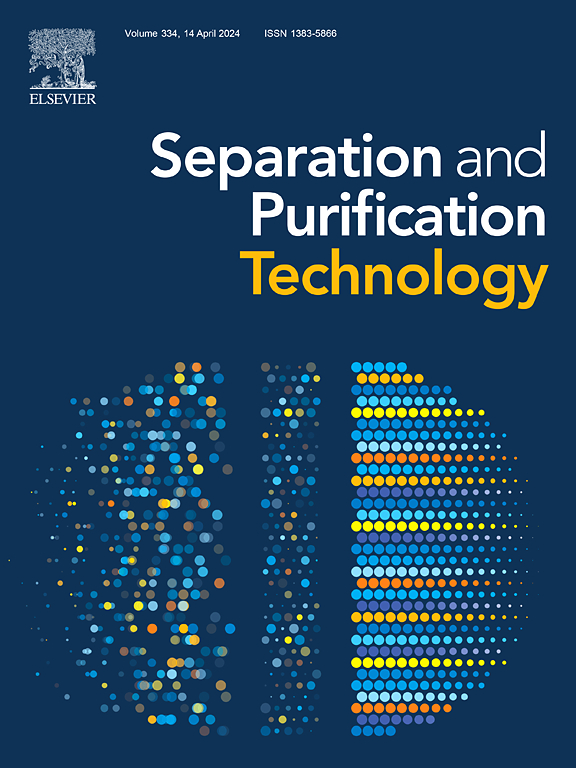Deep eutectic solvent-assisted synthesis of branched polypyrrole-coated lignocellulosic slurry: developing a composite with sponge-like structure for enhanced hexavalent chromium adsorption
IF 8.1
1区 工程技术
Q1 ENGINEERING, CHEMICAL
引用次数: 0
Abstract
Chromium (VI) in industrial wastewater poses severe ecological and health risks, yet developing efficient, sustainable adsorbents remains challenging. Herein, we introduce a new branched sponge-like polypyrrole (PPy)-coated lignocellulosic slurry (PPy@LCS) using deep eutectic solvents (DES) as a green polymerisation medium to construct a PPy@LCS/DES composite for effective Cr(VI) removal from wastewater. The PPy@LCS/DES was synthesized via in situ polymerization using acidic-based DES as a green solvent at 25–65 °C. The chemical characterizations confirmed the successful synthesis of branched PPy with a sponge-like structure. The spongy PPy achieved 98.9 % Cr(VI) removal, adhering to pseudo-second-order kinetics (chemisorption-driven) and Langmuir isotherm equilibrium, with an adsorption capacity of 1491 mg/g and a spontaneous and endothermic process. The mechanism involves Cr(VI) electrostatic attraction, reduction to Cr(III), and subsequent chelation by functional groups. Notably, the adsorbent retained >90 % efficiency over six regeneration cycles, underscoring reusability. The high efficacy of the PPy@LCS/DES removal was attributed to the unique structure and the abundance of functional groups as result of using DES. This work presents a sustainable and cost-effective solution for Cr(VI) remediation, leveraging renewable materials and the principles of green chemistry for environmental remediation.


深共晶溶剂辅助合成支链聚吡咯包覆木质纤维素浆料:开发一种具有海绵状结构的增强六价铬吸附复合材料
工业废水中的铬(VI)具有严重的生态和健康风险,但开发高效、可持续的吸附剂仍然具有挑战性。在此,我们引入了一种新的支状海绵状聚吡咯(PPy)涂层木质纤维素浆料(PPy@LCS),使用深共晶溶剂(DES)作为绿色聚合介质,构建PPy@LCS/DES复合材料,用于有效去除废水中的Cr(VI)。以酸基DES为绿色溶剂,在25-65 ℃下,通过原位聚合合成了PPy@LCS/DES。化学表征证实了成功合成具有海绵状结构的支链聚吡啶。海绵PPy对Cr(VI)的去除率达到98.9 %,符合准二级动力学(化学吸附驱动)和Langmuir等温平衡,吸附量为1491 mg/g,为自发吸热过程。其机制包括Cr(VI)静电吸引,还原为Cr(III),随后被官能团螯合。值得注意的是,吸附剂在六个再生循环中保持 >;90 %的效率,强调可重复使用。利用可再生材料和绿色化学原理,为环境修复提供了一种可持续的、具有成本效益的Cr(VI)修复方案。
本文章由计算机程序翻译,如有差异,请以英文原文为准。
求助全文
约1分钟内获得全文
求助全文
来源期刊

Separation and Purification Technology
工程技术-工程:化工
CiteScore
14.00
自引率
12.80%
发文量
2347
审稿时长
43 days
期刊介绍:
Separation and Purification Technology is a premier journal committed to sharing innovative methods for separation and purification in chemical and environmental engineering, encompassing both homogeneous solutions and heterogeneous mixtures. Our scope includes the separation and/or purification of liquids, vapors, and gases, as well as carbon capture and separation techniques. However, it's important to note that methods solely intended for analytical purposes are not within the scope of the journal. Additionally, disciplines such as soil science, polymer science, and metallurgy fall outside the purview of Separation and Purification Technology. Join us in advancing the field of separation and purification methods for sustainable solutions in chemical and environmental engineering.
 求助内容:
求助内容: 应助结果提醒方式:
应助结果提醒方式:


